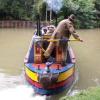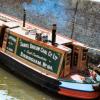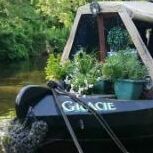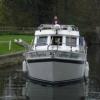Leaderboard
Popular Content
Showing content with the highest reputation on 09/11/13 in all areas
-
Well I managed to read through it all and it wasn't that difficult. Much better I thought than having to trawl through some of the inane and flippant comments that followed, especially from folk who couldn't even be @rsed to read it. I found it enlightening and I'm pleased that the CRT are not only engaging with and listening to we boaters but are actually trying to do something to improve matters. IMO since the CRT was set up there has been too much emphasis on non boating canal users so this makes a refreshing change. Well done CRT I say.8 points
-
Sometimes they can't win - damned if they do, damned if they don't.5 points
-
It seems this duplicate thread, rather than the original is where the discussion is now taking place. So for completeness, my thoughts from there.... I have several times today been accused of CRT-bashing. Not just on CWDF, but also on Facebook - yes, I can get myself in trouble anywhere! I think this is a bit harsh, as I have tried with others to work co-operatively with CRT for many months now, and in many areas a lot of progress has been made, and I think we are now in a "much better place", (how I hate that term - I really shouldn't use it!), than we ever were with BW. It is of course obvious that there are some areas where I believe they are still well off track, and I will continue to say what I think, but that should not undermine the many positives. I actually have exceedingly high hopes of Richard Parry. On the available evidence to date, I am very impressed with the approach he is taking. He has sensibly spent a period finding out exactly what he has inherited, and doesn't seem to have held back from getting out there and talking to a wide variety of canal users and his staff. He has been seen actively boating on a number of occasions, and has a habit of just turning up places, be they events, meetings, or just generally canal-side to see what is going on. The number of times I'm seeing (something like) "this bloke in a suit turned up, and I was talking to him, and it turned out to be Richard Parry" is impressive. Where else would you get repeated chances to talk to the chief executive of a major charity on a one to one basis, and have the chance to tell him how you feel about things. Numerous people have already had this opportunity, and he seems to be listening. Like any good person new at the top, he has, I feel sure, been data gathering before moving in heavily and changing anything much at all, but I have little doubt that he is already forming a very good view on what his priorities for change might be, and how he goes about it. I think announcements like this are the first indication he is now getting ready to move into that next phase. I don't think this is hot air, and I certainly think he plans to give it his very best shot. Whether there is so much inertia to change, (not just from CRT I would add, but also its BW knocking customers!), that he will have major difficulties remains to be seen. However I very much feel that if he can't turn things around, it is difficult to imagine anyone else stepping into the role and doing a better job. I sincerely hope I'm right, and am not revisiting this in a year or two and admitting that it hasn't happened, and that I was wrong about his intentions or his chances.2 points
-
It's not a press release, it's a public report. The original email from CRT was headed simply "Canal & River Trust publishes first report on project to support better and fairer use of towpath moorings" and the report doesn't call itself a press release. Given the amount of ink spilled here on the subject, I think CRT are entirely justified in treating it seriously enough to write 3000 words on it. Would you rather they'd issued a glib five-sentence précis?2 points
-
Ok, my shortened interpretation: We want to engage more with boaters as a whole. We are taking great steps to ensure that CC’ers understand what is required of them, including targeting people who are planning to buy boats and may be considering CC’ing. We will publish maps showing suggestions of routes that we would accept as compliant CC’ing. We will continue to work on options for hotspot areas where there is a large amount of long term non complaint cc’ing, to reach solutions for permits etc., for people who have bridge-hopped or moored there forever non-compliantly. We’re going to keep fecking about with visitor mooring stay times and signage. We are cracking down on ghost moorings and people who declare a mooring but apparently never use it. We will be more transparent about how enforcement works. More surveys, feedback panels and general consultation of boaters. We will do what we can to talk to and work with boaters who are having difficulties CCing. We’ve employed several new staff with new titles to help us do all of this at ground level. Though boaters are fecking hard work to talk to and deal with on occasion, we find that getting feedback and opening dialogue with boaters is over all beneficial to both parties. From Jan 14, all new CC’ers will get a letter within a month of declaring as a CC’er (how?!) explaining what is expected of them and how we monitor boat movements. We will also “give them feedback” throughout their first year to tell them what we think of their cruising pattern. We’re changing the CC1 letter to be more user-friendly. We’re going to sell short-term permits for staying on vacant (presumably unsold) long term moorings. The roving mooring permits in Cowley will begin in April 2014 Boaters on the Western end of the KandA are impossible and we are no closer to reaching a solution to overstaying. London is also full of non compliant CC’ers, we’re going to have lots of meetings about this, and arrange meetings between boaters and local residents in problem areas. If you’re a CC’er and getting in a pickle, we recommend talking to the waterways chaplain. We’re looking for places to put in more long term resi mooring berths in London, and are opening 19 in total during 2014. We are investigating 30 more potential spots too.2 points
-
2 points
-
TOWPATH MOORING MANAGEMENT PROJECT UPDATE – 8 NOVEMBER 2013 1. Introduction One of the first things trustees requested when they took over from British Waterways in July 2012 was a briefing on ‘non-compliant continuous cruising’. In September 2012 they and the Trust’s Council considered and endorsed a policy paper on the topic. As a result of this review, and after further planning, the Towpath Mooring Management project was created with additional funding of approximately £500,000 per year available from April 2013. The project is expected to last for at least three years from April 2013. A lot has happened since then, some of it behind the scenes, and this is the first of what will now be alternate-month reports on the project. This first report sets out our objectives, progress and what we plan to do over the coming months. It is therefore probably longer than we expect future reports to be. We hope you find this first report interesting and informative. If you have any comments or would like future reports to cover any particular aspect in greater detail, please drop a line to fran.read@canalrivertrust.org.uk. 2. Project Objectives We set some simple objectives to guide our work. They were: 1. To build more constructive engagement with all segments of the boating community. Develop communication strategies to build awareness of, and wider respect for, mooring rules to influence boater behaviour, thereby reducing dependence on legal enforcement sanctions. 2. Ensure that new ‘Continuous Cruisers’ are fully aware of and comply with requirements of the 1995 legislation. 3. Develop alternative mooring permit options for those Continuous Cruisers who have already established a lifestyle dependence which is not consistent with ‘bona fide’ navigation, as a stop-gap measure to address specific local issues. 4. Review visitor mooring provision, signage, communications and monitoring procedures at relevant sites. 5. Engage local stakeholders in the development and implementation of the actions arising from the project to build consensus. 3. Plans Our plans to achieve the objectives can be summarised under these six headings: 1. Communications, including: more use of boater views and feedback in the development of policy relating to towpath mooring; Page 2 of 6 strengthening understanding of mooring rules; reaching new continuous cruisers and people in the planning stages of boat purchase; and being clearer on how compliance monitoring and enforcement works. 2. New types of mooring permit exclusively and optionally available to already-established non-compliant continuous cruisers, plus local projects to develop tailored mooring plans for hotspot areas – London, the southern Grand Union & the western Kennet & Avon. 3. Assessment of visitor moorings and their management arrangements. 4. Community support for those liveaboard boaters who need it, delivered primarily through the Waterways Chaplaincy. 5. Promote and facilitate development of new affordable long term residential moorings. Below we report on progress for each of these six headings and also on issues and plans for the future. 4. Report on progress and plans 4a. Overview The project was intended in part to increase the resource we have available to make progress in this important area and so we have recruited five additional staff (two of whom are part time). The team comprises: Existing staff wholly or partly redeployed to the project Sally Ash (Head of Boating) Denise Yelland (Head of Enforcement) Fran Read and Damian Kemp (Communications) Antonia Zotali (Project Manager) New staff Sorwar Ahmed (Boater Liaison Manager, London) started April 2013 Matthew Symonds (Boater Liaison Manager, South) started June 2013 Sian Ferry (Project Co-ordinator) started July 2013 Two part time mooring rangers for London, Mikaela Khan-Parrack & Scott Hamilton, started October 2013 4b. Communications The appointment of the Boater Liaison Managers has been an important step in providing the time and skills to listen to often conflicting points of view and start the slow process of building relationships between people with a very wide range of views. Boater views and feedback The team has invested considerable and necessary time seeking discussion and receiving feedback. This often includes surveys, research, face to face meetings and specific structured workshops: Examples include: Page 3 of 6 Four workshops held with boaters, residents and other canal and towpath users in London to identify key issues and start to work up solutions Discussions with all interested parties at Noel Road, Islington Consultation papers and workshops around changes to the South East Waterway Visitor Moorings Discussions and workshops leading to a proposal for Roving Mooring Permits in the Cowley/Uxbridge area Work done by the Kennet & Avon Partnership with boaters to produce a mooring strategy Surveys amongst Grand Union and Kennet & Avon boaters to help refine proposals Our experience has been that, although dialogue can be slow and sometimes difficult, it produces results and improves relationships, making it a valuable investment for the future. We plan to maintain and increase dialogue over the coming months. Strengthening understanding of mooring rules For most boaters, compliance with mooring rules when away from their home mooring simply involves making sure they do not overstay the general 14 day rule or any specific local limits on stay times. To help boaters understand the Guidance better, we are developing some examples of movement patterns which we think illustrate compliance and non-compliance. We will discuss these with our Navigation Advisory Group and national boating organisations before publishing early in 2014. We are also considering publishing maps suggesting possible interpretations of places throughout the network which we will share in the same way before publishing. We also think there may be a need for greater clarity in respect of the home mooring definition in the light of increased cases of boaters declaring as a home mooring a location which they never use. This will be one of a small number of changes needed to licence terms and conditions which again we will discuss with the Navigation Advisory Group and boating organisations before publishing and communicating. Reaching new continuous cruisers and people in the planning stages of boat purchase From January 2014, everyone taking out a licence without a home mooring for the first time will receive a letter during the first month of their licence explaining how we monitor all boat movements, and that we will give them feedback regularly during their first year with early warnings if we believe they are not moving enough to qualify as a continuous cruiser. If this is the case, we will be clear that they must find a home mooring before we will renew the licence at the end of its first year. From January 2014, we will begin a communications campaign to get across the message that in order to buy a boat you must have a home mooring or comply with our Guidance. We will go beyond the usual waterway media to communicate with boat brokers and estate agents, and use social media as well as the more established channels. Clarity on how compliance monitoring and enforcement works Responding to early criticism of our former ‘pre CC1’ warning letter to continuous cruisers, we have changed this to be both friendlier and more informative (a copy of this can be found here). We will similarly re-visit all other standard enforcement letters and see if they can be made easier to understand. 4c. New types of mooring permit Winter mooring permits Page 4 of 6 A proposal for a more flexible permit than those offered in previous years (which were confined to visitor mooring sites) was developed from discussion amongst continuous cruisers. It features a new General Towpath Permit which on average is some 25% cheaper than last years’ site specific permits but excludes extended stays on visitor moorings or in places close to long term mooring sites. We announced this in June, publishing outline details of what would be on offer. This generated some useful feedback which included strong pressure for retaining an option for winter permits on some visitor mooring sites. Over the summer we refined the plans and have included the offer of permits at some 20 visitor moorings, priced on a par with long term mooring rates (as in previous years). Because previous schemes had thrown up complaints when permit holders found that overstayers were getting away with staying put without paying, we want to make sure that we are able to monitor overstayers more frequently in these places. In discussing the September 2012 policy briefing, Trustees specifically asked us to add into the mix the development of volunteer boat checkers, and over the past few weeks, we have managed to recruit for most of the sites. We recognise the risks in this and are doing all we can to mitigate these. The next few months will show us whether this is a viable method to roll out more widely. We are also taking the opportunity to test an alternative approach of using boatyards immediately adjacent to the mooring site for ‘three times a week’ recording – this is happening at four of the locations. We restricted sales of the new General Towpath Permit to continuous cruisers registered with us on 1 June 2013. Report of permits sold to 29/10/13 Permits sold General towpath permit (£5/metre/month (5 months)) 260 London towpath permit (£10/metre/month (5 months)) 63 Selected visitor moorings 47 Total 370 Roving mooring permits We worked closely with a Cowley and Uxbridge Boaters in the early part of 2013 to develop this concept and offer it on a trial basis in their area. We invited the 1,475 licence holders with home moorings on the Grand Union south of Blisworth and 404 continuous cruisers sighted regularly on the same stretch during the previous six months to take part in a survey on the subject of mooring. One third of people responded. The results can be viewed here. The proposed roving permits will be introduced from April 2014. An update issued in mid-October to Cowley & Uxbridge Boaters is published here. 4d. Visitor moorings management Our South East waterways are at, or near the top of, the league of boat numbers around the network and many user group participants have voiced concerns over both the appropriateness of time limits and how they are enforced. The waterway team had developed detailed proposals in consultation with local user groups which they were planning to implement in 2013. At the first meeting held with (predominantly) continuous cruisers following the Sept 2012 Trustees’ policy paper, it was clear that many were unaware of the proposals and were highly sceptical of the proposed changes. We therefore took breath, published a consultation and reflected on the findings. Both consultation paper and our report are published on our website. Page 5 of 6 By August we were ready to try out new arrangements at Foxton, Thrupp and Stoke Bruerne. These involve new signage and information leaflets explaining stay times and the consequences of overstaying. Volunteers have played an invaluable role in distributing information and recording boat arrivals on a daily basis, using our new Mobis web application. As a result, providing we devote sufficient time to supporting them, we are cautiously optimistic about the potential for wider use of volunteers for this purpose. We are currently completing a report on the project to present to a workshop of boaters (including many who attended a similar one in March) to be held on 6 November. The subject has been discussed by our Navigation Advisory Group who recommended that we should develop an overarching strategy for the review and management of visitor moorings, and part of the agenda at this workshop will be devoted to exploring views on this, alongside considering specifically the next steps for the busiest South East sites. 4e. Local projects There are currently two local projects: Kennet & Avon Canal, west of Devizes A community of residential boats started to become established along the towpath in Bath within a very short time of the canal’s reopening in 1990 following 40 years of dereliction. Successive generations of waterway management teams attempted (with varying degrees of vigour but without success) to persuade the boats’ owners to navigate in accordance with the requirements of the legislation. Since 2009 we have had regular dialogue with representatives of all sections of the boating community, parish councils and the District & County Councils in attempts to achieve agreement on measures to achieve fairer sharing of the scarce towpath mooring space. A specially formed steering group, which met eight times during 2010 and 2011, made some progress but failed to agree on a workable strategy. We incorporated some of their work into a draft framework mooring plan which we published in 2012 and invited a sub group of the new Waterway Partnership to refine this. The sub group did not support some of the fundamental principles of our plan and instead developed alternative proposals which are currently open until 29 November for public consultation. We still have concerns to the extent to which these proposals will make any material alteration to the availability of mooring space in the most popular locations for visiting boats, but in the spirit of localism and a desire to break the almost 20 year deadlock we have agreed to adopt their proposals for a 12-month trial period, subject to any amendments which emerge from the consultation. London London’s waterways have more, and a higher density of, non-compliant continuous cruisers than anywhere else on the network. Severe shortage of affordable homes in the capital is a major driver of growth. During 2012 we began to talk with boater and neighbourhood representatives though a series of professionally facilitated workshops. From this emerged a ‘Better Relationships Group’ – around 20 people with an interest in and commitment to working together to improve conditions on London’s waterways for boaters and local residents alike. Agenda themes of understanding capacity, improving communications, closer cooperation with local authorities and police, incident reporting, clearer and fairer enforcement processes, smoke and noise impacts on neighbours, visitor moorings management and provision and maintenance of boater facilities have emerged. Following the increase in budget from April 2013 and appointment of the Boater Liaison Manager we have made a start on tackling these many challenges. Activities to date have included: researching and presenting mooring demand and capacity information for the Greater London Authority’s special investigation into London’s mooring shortage; intensive engagement with London Borough of Islington and boater representatives on smoke and noise generated by boats, with the completion of a Page 6 of 6 management plan for the visitor mooring site; relationship-building with other riparian councils; and implementation of new winter mooring arrangements. We are trying hard to balance the pressures for ‘quick wins’ and the effective resolution of large numbers of individual complaints with the need for well-thought out, systematic strategies for all these issues. Our capacity was increased in early October with the recruitment of two part time mooring rangers (one of whom is a boater, the other a retired police officer). 4f. Community support We are aware that a small number of our boating customers have a wider range of social, financial or health needs and some have decided to come to our wonderful waterways in an effort to escape the pressures of modern living. We realise that supporting such people is not what the Trust was set up to do, however, as a caring Trust, we want to take into account the needs of all those people that use the waterways in the most appropriate way. As a result we are seeking to establish a partnership with Workplace Matters, an organisation established by a St. Albans based charity, to develop a network of Waterway Chaplains who can help people who may need some friendly advice and support. Over the past three years, Workplace Matters has worked skilfully along our towpaths, largely concentrating in the South East. Primarily using word of mouth, they come into contact with those boaters who may need help at specific times in their lives. Often the Chaplains help act as advocate for the boater, liaising with our enforcement staff and with local authority housing and social care departments so that debts can be paid, a home mooring can be secured, disputes with other waterway users can be resolved or alternative accommodation on land can be found. We have made a small grant to Workplace Matters to fund an administration and fundraising assistant with the aim of increasing the capacity and sustainability of the Waterways Chaplaincy. Our fundraisers are helping by developing grant applications for funds to strengthen the chaplaincy’s work. 4g. Long term residential moorings Over the last 18 months, colleagues in our Commercial Directorate have been researching locations for the development of new mooring sites in London. Three small developments, with a total of 19 berths, are scheduled to be completed during 2014 at Acton’s Lock on the Regents Canal, Atlip Road on the Grand Union Paddington branch at Alperton, and Matchmakers Wharf, Homerton, on the lower Lee. During the course of this work, we have identified some 30 sites along the offside which are not large enough to be commercially viable but which, subject to further research, might be of interest to a social enterprise. We are therefore working on initial site assessments and a form of prospectus to explain the process for developing a small offside mooring for residential use, along with a directory of locations for social enterprises to consider. Sally Ash, Head of Boating 8 November 20131 point
-
Gracie - Befpre cratch cover, dodger & tonneau and after - we are going to repaint her we think1 point
-
LOL ... loads of love? laugh out loud? Nope ... little old ladies ! prattle prattle ... FFS grow up ... ...1 point
-
Because I applied and was selected, and how do you know that I don't have a boat or ties to the area and what does this mean in any event. What makes you such a self important half wit?1 point
-
I have to say I'm with Julynian on this. A surfeit of blue LEDs makes even very expensive computer kit look like cheap Chinese crap. I fear it would do the same to a narrowboat. MP.1 point
-
My understanding was that the only place any 14 day "winter" signs got erected on that stretch was at either end of the disabled moorings, (albeit without arrows initially to indicate they only referred to the disabled mooring). So are you now saying their were poles further to the tunnel that did for a while say 14 days until today? Has anyone actually got photos of this apparently ever changing situation? If all this is really happened, (did it?), there is clearly a cost assosciated with each team that gets sent out to remove or change something already erected in error.1 point
-
LED technology has been around for years, a statement of fact, indeed they have been. LEDs are produced and graded after each chip has been tested against the design specification. Following testing LEDs are segregated into quality bins, not surprisingly the process is known as binning. The difference between the best quality LEDs and the lowest quality ones can be very significant. The price charged is of course dependent on the quality, the better quality binned ones are far more expensive, indeed often ten fold more expensive than the lowest quality chips. The low quality LEDs often known as orphan LEDs, are sold off to lamp assemblers where they can be found included in many low cost lamps. Whilst they work many have latent defects that often result in a shorter working life, it's a lottery what you buy and there is often no warranty provided. It's absolutely fine if boat owners wish to purchase low cost resister controlled LED lamps after understanding the differences between those and the more sophisticated products which are available. The fact is many boat owners have purchased resistor controlled lamps whilst being completely unaware of the issues involved and advantages of one type and the other. Incidentally, it is rather rude to denigrate my technical qualifications when you have no idea who I am. In fact I am a professionally qualified electrical engineer with 40 years experience and a member of the Institution of Engineering and Technology (Institute of Electrical Engineers). Maybe you would like to share your qualifications with the forum members. Regards Adrian Jones1 point
-
Not really strange, but it amused me at the time. We had come up from the Blue Lias with the another boat and were in the middle Calcutt lock, Jan was on the boat and I was forward lock wheeling whilst the other boat crew worked the middle lock. As I started to draw the top lock, a boat launched out of the fueling point and headed for the lock. I ponted out that there were two boats coming up but the steerer demanded that the lock was his as he was "in the pound before us" I pointed out that he was on the fuel point |(presumably fuelling up) not really "waiting in the pound" and that there was no one from his boat preparing the lock, but all to no avail. The interloping boat steerer became quite irritated, insisting that we were stealing his lock, so I told him he could have the lock if he felt so strongly about it, dropped the top lock paddles and walked back to the middle lock, leaving him stranded in the middle of the pound without anyone on the bank to work the lock. I was in no hurry as our mooring is only half a mile beyond the top lock, but it took him nearly ten minutes of faffing about to get off the boat, and prepare the lock, and he had to work it all on his own. As I said, not that strange but amusing (well to me!)1 point
-
Agree with Blackrose. The only thing you should put on the inside of your hull is bilge paint or barge grease - preferably the latter. And ensure you have good access to check it is dry. Boats rust from the inside, not from the outside.1 point
-
Not yet, I'm still working on it. I must admit to be rather overwhelmed with the response (far beyond what I'd anticipated), plus have had some time off with illness, but hopefully not too much longer! I'm fitting it in around a full time job too so it's not as quick as it would be if inwere richer Please accept my apologies.1 point
-
I hope something is to be done. If we read through all the 'innocent' protests there is a problem that needs sorting. Those who are genuine have nothing to worry about, and those hoggers that overstay on time limited moorings need to be educated as well. Do they need a bigger stick to be beaten with, or will they claim foul because they have no personal responsibility? Its no different to the roads. Near me is a 30min timed parking bay. Many people overstay by hours and even days. The signs are clear, but people are just too lazy. They just move the car when a traffic warden arrives....they have 30mins to do so. My point? When too many people take advantage, the point of the spaces are compromised. Local businesses lose out and the only gain is some lazy person gets to have a closer walk to work (we have 3 free car parks in 2-5 min walking distance). So the choice is remove the spaces and everybody loses out or employ a better solution that eliminates 'warden watchers'.....car cameras. And you know what? People will complain, mostly those who gave them their purpose. The same for the waterways, if you cant be sensible and have personal respect and responsibility....or care for laws and rules, you will be treated like children, a vote for a big brother society. If you respect our freedom, don't give it away so easily.1 point
This leaderboard is set to London/GMT+01:00
















